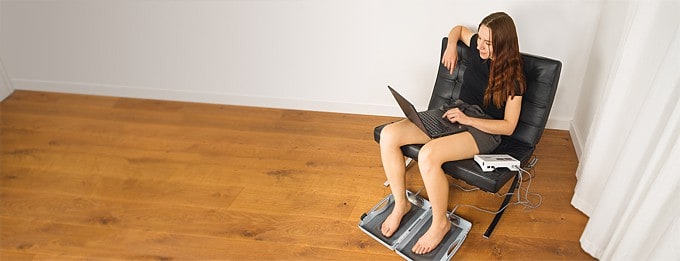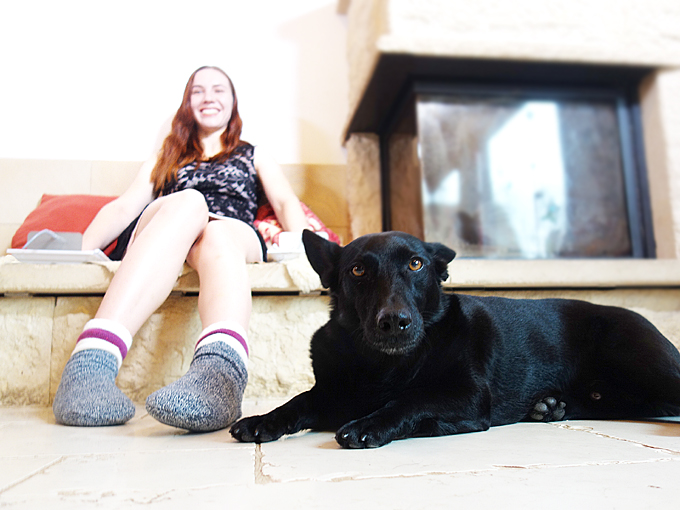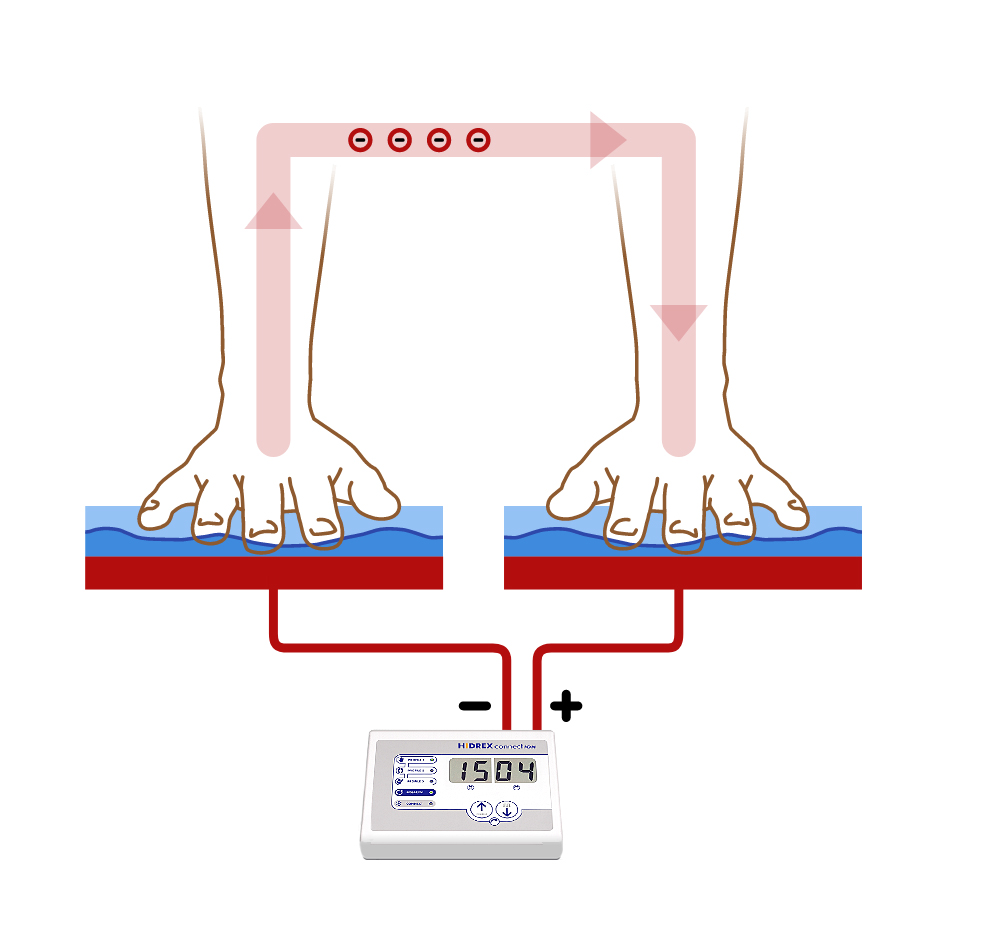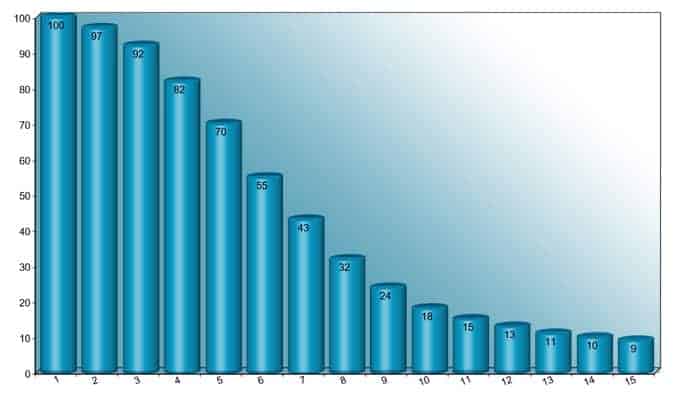Subtotal: 75,00€
incl. 19% VAT: 11,97€
What is iontophoresis?
Iontophoresis is a recognized form of therapy for hyperhidrosis or excessive sweating.
Iontophoresis acts on the sweat glands by guiding an electric current through the skin.
This prevents the production of excessive sweat.
The exact mechanism at work remains unknown, but the success speaks for itself.
Iontophoresis has a high chance of success, but doesn’t work for everyone.
Two electrodes, a little water in the treatment tubs, an iontophoresis device, and you're good to go.
An almost imperceptible treatment current flows from one electrode to the other.
The iontophoresis current is safe and harmless, as long as you observe a few rules. This includes, for example, the removal of all jewellery.
What is iontophoresis? - How is it used? - How do you optimize the therapy to reach the best success?
Links to the most frequently asked questions:
What does iontophoresis mean?
Is iontophoresis difficult to use?
Does iontophoresis work?
When does it take effect?
What is the frequency and length of the treatment?
Which body parts can I treat with iontophoresis?
Pulsed current or direct current?
Optimizing the therapy
Advantages - what are the benefits?
Is iontophoresis right for me?
Which device suits my personal goal?



During the hand treatment, the palms rest comfortably in the tubs without exerting pressure. The tubs contain a small amount of water, usually tap water, hence the name tap water iontophoresis. The large-scale electrodes placed into the tubs are covered with a close-meshed grid or a towel. This prevents any direct skin contact with the electrodes. An iontophoresis device is connected via insulated cables. The gentle iontophoresis current flows along the skin from one hand to the other and causes light tingles.
Example: A comfortable iontophoresis hand treatment: the treatment tubs are placed to either side of the user, the user's position is relaxed and cozy.
This question requires a detailed explanation! The bad news first: unfortunately, iontophoresis does not work for everyone. The good news: in many cases, you can work on achieving success! Are there reasons for failure?
Please note our sections:
Therapy & Details, as well as Iontophoresis Tips

A BASIC QUESTION: When does the effect of the iontophoresis treatment show, when should an effect be observed at the latest? This question will be familiar to every new user who is just getting started on the therapy. This is natural - of course you are impatient to reach success with your iontophoresis therapy!
A closer look at the statistics answers some questions. Source of data below: Bindner Medical surveys

Percentage of users that still experience sweating after a given number of days. After 6 days, about half of the users have already reached success.
Once you have started your iontophoresis therapy, your sweating should change after ~ 10 days. -> Find out more!
Prepare in advance for a slightly longer waiting period. If there is no result after 10 days: don't panic, it's possible that it just takes a little longer in your case. After 3 weeks, you should stop the wait and take action. One reason why iontophoresis might not work properly or might show suboptimal results can be very mundane: in part, the reason is simply the iontophoresis device. Each device is different from the next.
It is highly important to select your iontophoresis device carefully.
Please note our selection aid / guide for iontophoresis: Device selection - electrode material - current type - accessories
The main use of iontophoresis is the treatment of sweaty hands, feet and armpits, i.e. limited areas of the skin with a great number of sweat glands. There are special electrodes for the treatment of the forehead, head, neck, shoulders, and so forth. 88% of our iontophoresis users treat their hands and feet. Another 7% treat their underarms.

The special areas are included at ~ 5%. Of these users, 3% treat their face / forehead / head, 1% treat their abdomen and back, and another percent use iontophoresis for other areas.
In addition to the special areas, our users usually treat one of the classic body parts such as hands, feet, or armpits.
32% of our users treat more than one area.
In the beginning of the therapy, daily treatments must be performed until the sweating stops. For the majority of users, this initial therapy lasts approximately 10 days. The skin requires time to get used to the electric stimulus. This effect can be achieved through daily "training" during the initial therapy. It takes a certain time and a certain dosage for the current to develop its effect. Following this daily training, the required treatment time can be gradually reduced. In the long run, the most common treatment frequency is 15-30 minutes per week. Do you need more than 30 minutes a week? In this case, you can search the structure of your therapy and the therapy process for errors.

Therapy at home? A home therapy device is often a must, since the only alternative is to see a doctor 1-2 times a week. Travel, waiting times, travel costs - it pays off to have your own home device.
Our time-proven experience has shown: 1) that the treatment is usually very easily tolerated when using a pulsed current, 2) that the pulsed current may increase the success rate, 3) that the pulsed current may shorten the treatment times. To sum it up: from our point of view, pulsed current is one of the most important factors when optimizing the iontophoresis treatment.
Optimizing iontophoresis Iontophoresis is a very "tricky" therapy. The difficulty is not the current itself, but to figure out how the electricity should applied so that the desired goal can be reached in a reasonable amount of time. Often the success depends on details, such as the correct water level (neither too high - nor too low), the tap water, and settings in need of optimization - or it depends on the iontophoresis device in use. Please see our topic Optimizing Iontophoresis.
This is where the difference between the various types of iontophoresis devices and the technology used therein becomes obvious. A good iontophoresis device is a sound basis. It must be able to provide the desired gentle currents in order to reach the threshold value that is required for the effect to occur.
The iontophoresis threshold value depends on the individual. This personal value can be very low or very high. The higher this value, the higher the treatment current has to be to achieve an initial success. If this value cannot be exceeded, success will be difficult.
At this point, the fine art of iontophoresis begins. In these cases, pulsed currents and variable pulsed currents are a great advantage, as with the Hidrex ConnectION. The following factors are a direct influence on the success of your iontophoresis therapy:
- Length of the iontophoresis (iontophoresis session)
- Frequency of the iontophoresis treatment (how many times per week)
- Current strength or amperage
- Optimal treatment setting (pulse width, water height)
If one of these factors is suboptimal, problems often arise in regard to the success and the required treatment time of the iontophoresis therapy. Which iontophoresis device is the right one?
You can choose: an easy usage versus the ability to set up precise parameters, an assortment of differences. Taking all these factors into account, not every device is equally suitable. Nowadays, there are many providers on the iontophoresis market, some of them are newcomers, others are long-term manufacturers of these devices.

Answering this question with a definite yes or no requires a first-hand trial.
If you have not tried iontophoresis even once, it is difficult to say whether this treatment is right for you personally. If you are not afraid of electricity and have a little time to spare, such a trial is certainly worthwhile.
There is no reason to fear the electricity: pulsed currents allow for a very gentle procedure, which means that many users hardly notice the therapy and even the higher currents remain comfortable. The current intensity can be regulated and adjusted to make sure that the user does not notice the current flow.
Advantages of iontophoresis
Iontophoresis has been in use for a long time
The usage of iontophoresis for the treatment of hyperhidrosis was developed in the 1950s, and has been deployed ever since. The effect of the electricity on the human body has been observed for centuries. In antiquity, electric eels were used for treatments and therapies (although we are glad that this is no longer the go-to method). Iontophoresis was not invented, but rather discovered by accident, as a therapy for hyperhidrosis. Electricity and electric baths have been employed for a long time to treat a wide variety of diseases. By coincidence, some patients reported an effect on their sweating. At the beginning of the treatment, the procedure was only used sporadically in a few clinics. Slowly, the iontophoresis treatment began to gain popularity.
Nowadays, most university hospitals and many medical practices own an iontophoresis device. In our opinion, a home therapy device should always meet professional standards. We advise against using self-made iontophoresis devices. The current intensity of a home-made product might be too much to handle. Iontophoresis devices are medical products! Qualified devices meet the highest technical requirements and are used daily at home as well as professionally by doctors, dermatologists, and clinics all over the world!